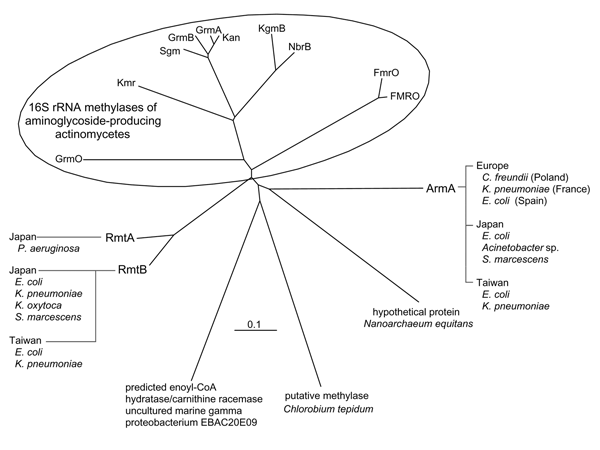Volume 11, Number 6—June 2005
Dispatch
Global Spread of Multiple Aminoglycoside Resistance Genes
Figure

Figure. . Phylogenic relationship among the 16S rRNA methylases. Each amino acid sequence was subjected to the analysis referred to the following sources: FmrO, accession no. JN0651; Kmr, accession no. AB164642; GrmA, accession no. M55520; GrmB, accession no. M55521; GrmO, accession no. AY524043; Kan, accession no. AJ414669; Sgm, accession no. A45282; KgmB, accession no. S60108; NbrB, accession no. AF038408; FMRO, Q08325; RmtA, (6); RmtB, (7); ArmA, (8); predicted enoyl-CoA hydratase/carnithine racemase of uncultured marine gamma proteobacterium EBAC20E09, accession no. AAS73112; putative methylase of Chlorobium tepidum, accession no. AAM72273; hypothetical protein of Nanoarchaeum equitans, accession no. AAR39385. The ClustalW program provided by the DNA Data Bank of Japan (http://www.ddbj.nig.ac.jp/search/clustalw-e.html) was used in this study.
References
- Schwaber MJ, Cosgrove SE, Gold HS, Kaye KS, Carmeli Y. Fluoroquinolones protective against cephalosporin resistance in gram-negative nosocomial pathogens. Emerg Infect Dis. 2004;10:94–9.PubMedGoogle Scholar
- Zanetti G, Bally F, Greub G, Garbino J, Kinge T, Lew D, Cefepime versus imipenem-cilastatin for treatment of nosocomial pneumonia in intensive care unit patients: a multicenter, evaluator-blind, prospective, randomized study. Antimicrob Agents Chemother. 2003;47:3442–7. DOIPubMedGoogle Scholar
- Kurokawa H, Yagi T, Shibata N, Shibayama K, Arakawa Y. Worldwide proliferation of carbapenem-resistant gram-negative bacteria. Lancet. 1999;354:955. DOIPubMedGoogle Scholar
- Sahm DF, Thornsberry C, Jones ME, Karlowsky JA. Factors influencing fluoroquinolone resistance. Emerg Infect Dis. 2003;9:1651–4.PubMedGoogle Scholar
- Shaw KJ, Rather PN, Hare RS, Miller GH. Molecular genetics of aminoglycoside resistance genes and familial relationships of the aminoglycoside-modifying enzymes. Microbiol Rev. 1993;57:138–63.PubMedGoogle Scholar
- Yokoyama K, Doi Y, Yamane K, Kurokawa H, Shibata N, Shibayama K, Acquisition of 16S rRNA methylase gene in Pseudomonas aeruginosa. Lancet. 2003;362:1888–93. DOIPubMedGoogle Scholar
- Doi Y, Yokoyama K, Yamane K, Wachino J, Shibata N, Yagi T, Plasmid-mediated 16S rRNA methylase in Serratia marcescens conferring high-level resistance to aminoglycosides. Antimicrob Agents Chemother. 2004;48:491–6. DOIPubMedGoogle Scholar
- Galimand M, Courvalin P, Lambert T. Plasmid-mediated high-level resistance to aminoglycosides in Enterobacteriaceae due to 16S rRNA methylation. Antimicrob Agents Chemother. 2003;47:2565–71. DOIPubMedGoogle Scholar
- Yan JJ, Wu JJ, Ko WC, Tsai SH, Chuang CL, Wu HM, Plasmid-mediated 16S rRNA methylases conferring high-level aminoglycoside resistance in Escherichia coli and Klebsiella pneumoniae isolates from two Taiwanese hospitals. J Antimicrob Chemother. 2004;54:1007–12. DOIPubMedGoogle Scholar
- Yamane K, Doi Y, Yokoyama K, Yagi T, Kurokawa H, Shibata N, Genetic environments of the rmtA gene found in Pseudomonas aeruginosa clinical isolates. Antimicrob Agents Chemother. 2004;48:2069–74. DOIPubMedGoogle Scholar
- Lambert T, Galimand M, Sabtcheva S, Courvalin P. The armA aminoglycoside resistance methylase gene is borne by composite transposon Tn1548 [Abstract C1-1496]. Presented at the 44th Interscience Conference on Antimicrobial Agents and Chemotherapy; Washington; 2004 Oct 30–Nov 2.
- Doi Y, Wachino J, Yamane K, Shibata N, Yagi T, Shibayama K, Spread of novel aminoglycoside resistance gene aac(6')-Iad among Acinetobacter clinical isolates in Japan. Antimicrob Agents Chemother. 2004;48:2075–80. DOIPubMedGoogle Scholar
- Galimand M, Sabtcheva S, Kantardjiev T, Poirel L, Arlet G, Courvalin P, The armA aminoglycoside resistance methylase gene is disseminated in Enterobacteriaceae by an incL/M plasmid mediating CTX-M-beta-lactamase [Abstract C2-59]. Presented at the 43rd Interscience Conference on Antimicrobial Agents and Chemotherapy; Chicago; 2003 Sep 14–17.
- Frieden TR, Munsiff SS, Low DE, Willey BM, Williams G, Faur Y, Emergence of vancomycin-resistant enterococci in New York City. Lancet. 1993;342:76–9. DOIPubMedGoogle Scholar